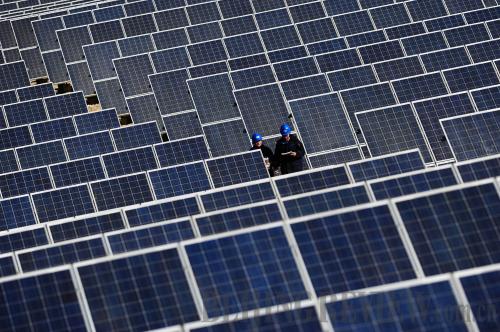|
 |
|
CLEAN ENERGY: Two workers check solar panels at a solar power plant in northwest China's Qinghai Province on March 1 (ZHANG HONGXIANG) |
The situation in China is similar. According to a climate change report China released in November 2011, the average temperature of China's land surface has increased 1.38 degrees Celsius since 1951. 2007 was the warmest year during the past century in China, and 2001-10 was its warmest decade.
China's average temperature in 2011 was 9.3 degrees Celsius, 0.5 degrees higher than the average temperature from 1971-2000, making 2011 the 14th warmest year since 1951.
Ding Yihui, Deputy Director General of China's Climate Change Experts Committee, said while the average land surface temperature is on an upward trajectory, there can be short- or long-term fluctuations. It is normal that a certain period is colder or warmer than usual.
For example, 1920-40 and 1970-2000 were relatively warmer periods, while the first two decades in the 20th century and 1950-70 were colder periods. According to World Meteorological Organization standards, only when the average temperature during 30 years shows obvious changes compared with the average temperature of the previous 30 years, can a new climate change tendency be confirmed, Ding said.
Since the Industrial Revolution started in the 18th century, greenhouse gas concentrations in the atmosphere and the average land surface temperature have both increased. The trend is clearer in the Northern Hemisphere, which has more human-generated greenhouse gas emissions, than in the Southern Hemisphere. This is evidence that greenhouse gas emissions from human activities are probably a major cause of climate change, Luo said.
Despite possible benefits to agriculture, global warming threatens the world with a rising sea level, which will cause great harm to coastal areas. "If global warming proceeds slowly in the next 50 to 100 years, it will create both advantages and disadvantages. But if it goes too fast for ecological, economic and social systems to adapt to the changes, its consequences will be unfavorable and even disastrous," Luo said.
Ding believes it is still hard to say whether global warming will escalate in the near future. This is possible as greenhouse gas emissions keep going up. But countries around the world are intensifying efforts to cut emissions, and the role of oceans in regulating temperatures remains unknown. It will take several more years to draw a confirmed conclusion on the pace of global climate change, he said.
Putting the pace and effects of climate change aside, experts say efforts to save energy and control greenhouse gas emissions will be a boon for China's economy. A "green transformation" will not only help protect the environment but also contribute to China's industrial upgrading.
Ding said whether the globe becomes colder or warmer, changing the unsustainable economic development mode to realize a green transformation is a good choice for China. The country should adjust its economic and social development plans to promote industries with low greenhouse gas emissions and environmentally friendly practices.
"The key is to promote green development and low-carbon economy to accelerate the transformation of its development mode," he said.
Du Xiangwan, a research fellow with the China Academy of Engineering Physics, said there are indeed some countries in the world trying to force China to take on excessive emission reduction obligations as a tactic to restrain China's rapid economic development. But he stressed "energy conservation" and "emission reduction" are not merely trendy concepts in international climate negotiations, but are indispensable to China's healthy development.
| 